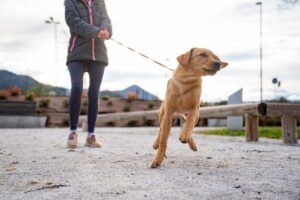 Barking is one of the primary ways dogs communicate, whether it’s to show excitement, alert you to something, or interact with other canines. However, excessive barking during walks—especially when passing another dog—can be disruptive and stressful for everyone involved. It’s not only difficult for you as the dog walker but can also create tension with other dogs, pedestrians, or neighbors.
Barking is one of the primary ways dogs communicate, whether it’s to show excitement, alert you to something, or interact with other canines. However, excessive barking during walks—especially when passing another dog—can be disruptive and stressful for everyone involved. It’s not only difficult for you as the dog walker but can also create tension with other dogs, pedestrians, or neighbors.
Learning how to manage and reduce barking can make your walks far more enjoyable, while also addressing the root of your dog’s behavior.
If your dog tends to bark at other dogs during walks, there are practical and effective strategies you can use to reduce the barking and redirect your dog’s attention. With patience, consistency, and a few new techniques, you can ensure a calmer and more pleasant walking experience for both you and your furry friend.
Choose the Right Leash and Harness
A key step in managing barking and lunging during walks is having the proper leash and harness setup. Dogs may instinctively lunge at other dogs while barking, which can make it harder for you to maintain control. A sturdy, no-pull harness is one of the safest and most effective tools to use in these situations. It reduces strain on your dog’s neck and body while giving you better leverage without causing discomfort.
Hold the leash firmly but avoid yanking on it, as sudden pulls can escalate your dog’s excitement. The goal is to keep your movements calm and controlled, helping your dog feel more secure and less reactive. A proper leash and harness combination can go a long way in preventing lunging behaviors and making it easier to redirect your dog’s focus.
Explore New Walking Routes
If your current walk route is full of distractions like other dogs or bustling crowds, considering a change of scenery can help. Look for quieter areas with fewer triggers—in parks, nature trails, or low-traffic neighborhoods—to help minimize barking opportunities. A new environment may also provide fresh stimuli, keeping your dog more focused on exploring than reacting to what’s around them. Once your dog learns to stay calm in less crowded areas, you can slowly reintroduce busier environments as their behavior improves.
Walk Away When Necessary
If you see another dog coming your way and know that your dog is likely to bark, one of the simplest strategies is to calmly turn around and walk the other way. This eliminates the visual trigger that prompts your dog to react. Teaching your dog a verbal cue like “let’s go!” can make this maneuver more seamless. When your dog follows you without barking, offer treats and verbal praise to reinforce their positive behavior. Over time, they’ll begin to learn that walking away is a rewarding experience.
Create a Diversion
 Sometimes walking the other way isn’t a practical option. In these cases, creating a distraction can be highly effective. Bringing treats or a favorite squeaky toy on your walk can help redirect your dog’s attention. Toss a handful of treats on the ground for your dog to sniff and pick up, or engage them with their toy. Engaging them with something positive can redirect their focus and prevent barking until the situation has passed.
Sometimes walking the other way isn’t a practical option. In these cases, creating a distraction can be highly effective. Bringing treats or a favorite squeaky toy on your walk can help redirect your dog’s attention. Toss a handful of treats on the ground for your dog to sniff and pick up, or engage them with their toy. Engaging them with something positive can redirect their focus and prevent barking until the situation has passed.
Practice Relaxation Techniques
Barking often stems from anxiety or overexcitement, particularly when a dog feels tense on a leash or overstimulated by their surroundings. Teaching your dog to relax in the presence of other dogs can take time but is well worth the effort. Start by allowing your dog to observe other dogs from a distance at which they remain calm. Reward your dog for staying quiet with treats and praise.
As your dog becomes more comfortable, gradually decrease the distance between them and the other dogs, always rewarding calm behavior. With consistent practice, your dog learns that being quiet and relaxed earns positive rewards. Over time, this behavior becomes second nature.
Train to Heel on Command
Training your dog to heel is an excellent way to curb barking and lunging. Teach your dog the “heel” command in controlled environments first, such as in your home or backyard. Once they’ve mastered the behavior, practice it during walks. When your dog successfully comes to heel, offer rewards and praise to reinforce the behavior.
Even if your dog barks at first, consistently practicing the “heel” command shifts their focus to you and away from external triggers. This is a great way to teach your dog to remain calm and responsive during walks.
Add Challenges to Your Walk
A lack of mental stimulation can often lead to barking. By incorporating small challenges during your walk, you can keep your dog focused and engaged. Try varying your speed, changing directions unexpectedly, weaving around obstacles like trees or benches, or practicing basic commands like “sit” and “stay” along the route.
Not only do these challenges provide mental exercise, but they also prevent barking by giving your dog new tasks to concentrate on. Engaging their physical and mental energy creates a more fulfilling walk.
Stay Calm and Consistent
Your own demeanor has a considerable impact on your dog’s behavior. If you’re tense, frustrated, or anxious during a walk, your dog is likely to pick up on those emotions and react accordingly. Remaining calm, confident, and composed can help your dog feel more secure and less reactive.
Consistency is also key in any training effort. Keep practicing the same strategies to ensure your dog understands what’s expected of them. Improvements may take time, so be patient and celebrate small victories along the way.
Support from Professional Dog Walkers
 Managing barking during walks can be challenging, especially for novice owners or those with limited time for consistent training. When you need an extra set of hands, professional dog walkers can make all the difference. At Paw Pals Pet Sitting, our experienced dog walkers are trained in effective techniques to manage barking, lunging, and other reactive behaviors during walks.
Managing barking during walks can be challenging, especially for novice owners or those with limited time for consistent training. When you need an extra set of hands, professional dog walkers can make all the difference. At Paw Pals Pet Sitting, our experienced dog walkers are trained in effective techniques to manage barking, lunging, and other reactive behaviors during walks.
Paw Pals provides customized dog walking services tailored to your pet’s unique needs. Whether your dog requires mid-day exercise, specific behavioral assistance, or just a friendly walker to brighten their day, we’re here to help. If barking is a persistent issue, our skilled walkers can help reinforce positive behavior during their walks, reducing stress for both you and your dog.
Beyond walking services, Paw Pals also offers pet sitting, ensuring your dog has a safe and loving environment even when you’re away. Whether it’s a mid-day visit, extended care, or an overnight stay, we’re committed to providing top-notch care to keep your pup happy and healthy.
Reach Out Northern Virginia’s Top Dog Walkers
Barking during walks is a common challenge for many dog owners, but with the right strategies, it’s a behavior that can be successfully managed. From choosing the right equipment to incorporating relaxation and training techniques, your efforts will help create calmer, more enjoyable walks.
If managing barking still feels overwhelming, don’t hesitate to seek support from professionals like those at Paw Pals. Contact us today to schedule your first walk or to explore our full array of pet care services offered in Northern Virginia. Together, we’ll help your dog become a confident, calm, and happy walking partner.


